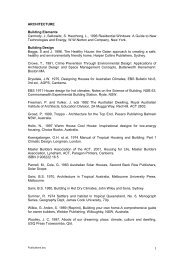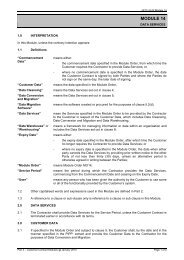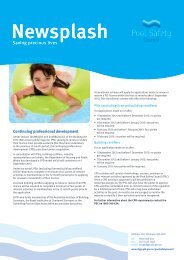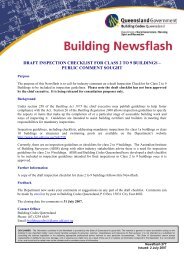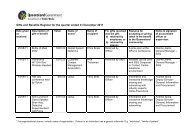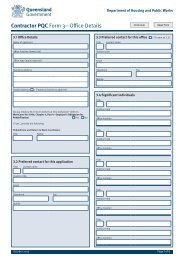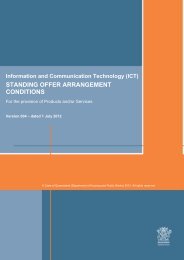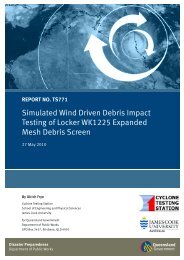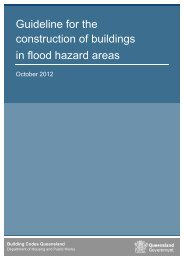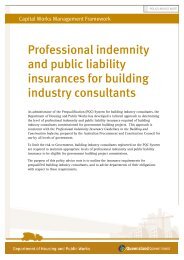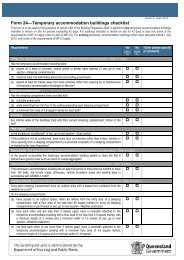QFleet Road Safety Manual - Department of Housing and Public ...
QFleet Road Safety Manual - Department of Housing and Public ...
QFleet Road Safety Manual - Department of Housing and Public ...
Create successful ePaper yourself
Turn your PDF publications into a flip-book with our unique Google optimized e-Paper software.
Risk 3: Fatigue<br />
Fatigue is mental or physical tiredness that<br />
negatively affects a person’s ability to function. It<br />
may impair performance by reducing attentiveness,<br />
slowing reaction times, affecting judgement <strong>and</strong><br />
reducing performance on tasks which require skilled<br />
control, like driving.<br />
Compared to drivers <strong>of</strong> non-fleet vehicles, fleet<br />
drivers may be at an increased risk <strong>of</strong> fatigue.<br />
Fatigue is one <strong>of</strong> the main contributing factors in<br />
work-related road crashes. 16 The main cause <strong>of</strong><br />
driver fatigue is a lack <strong>of</strong> quality sleep. The effects <strong>of</strong><br />
fatigue are cumulative <strong>and</strong> fatigued drivers are <strong>of</strong>ten<br />
not aware <strong>of</strong> their condition.<br />
Fatigue is associated with the following factors:<br />
• sustained mental or physical effort<br />
• inadequate rest breaks<br />
• environmental stresses (such as heat, noise <strong>and</strong><br />
vibration)<br />
• disruption <strong>of</strong> circadian rhythms (normal cycles <strong>of</strong><br />
daytime activity <strong>and</strong> night sleep)<br />
• long periods awake<br />
• inadequate amount or quality <strong>of</strong> sleep over an<br />
extended period.<br />
Signs <strong>of</strong> driver fatigue such as lane drifting,<br />
variations in speed, delayed reactions <strong>and</strong> reduced<br />
concentration, indicate there is already a risk.<br />
Individuals are <strong>of</strong>ten unreliable judges <strong>of</strong> their level<br />
<strong>of</strong> fatigue. Consequently, the role <strong>of</strong> the employer in<br />
planning <strong>and</strong> scheduling work to minimise fatigue is<br />
paramount.<br />
Risk can be reduced by:<br />
• underst<strong>and</strong>ing the signs <strong>of</strong> fatigue<br />
• having sufficient sleep before driving <strong>and</strong> not<br />
driving when feeling tired<br />
• avoiding or minimising alcohol consumption<br />
prior to driving<br />
• taking 15 minute rest breaks with exercise after<br />
every two hours <strong>of</strong> driving<br />
• sharing the driving<br />
• using alternatives such as public transport or<br />
taxis<br />
• not driving in the hours when normally asleep<br />
e.g. midnight to dawn<br />
• not starting a long trip after a full day’s work<br />
• avoiding driving long distances after consuming<br />
a large meal; light snacks are recommended<br />
• not using the vehicle’s heater because it can<br />
induce drowsiness<br />
• keeping the cabin well ventilated <strong>and</strong> at a<br />
comfortable temperature<br />
• keeping mind active e.g. listening to the car<br />
radio<br />
• not getting too comfortable; use wind, noise<br />
<strong>and</strong> an upright seating position to remain alert<br />
• stopping to have a sleep if required<br />
• maintaining good levels <strong>of</strong> health <strong>and</strong> fitness<br />
through good diet <strong>and</strong> exercise<br />
• avoiding medications which cause drowsiness<br />
• breaking the journey with an overnight stop, if<br />
appropriate.<br />
For further information relating to fatigue see the<br />
Courteous <strong>and</strong> safe driving behaviour section <strong>of</strong> the<br />
<strong>QFleet</strong> Safe Driving Guide.<br />
16 Symmons, M. & Haworth, N. op. cit.<br />
<strong>Road</strong> <strong>Safety</strong> <strong>Manual</strong><br />
15



